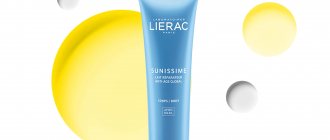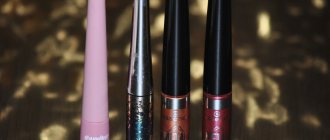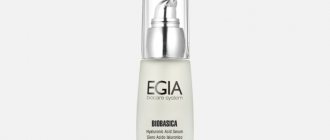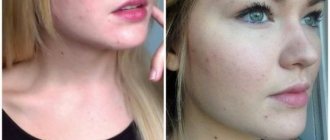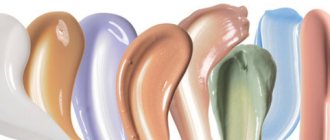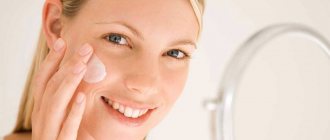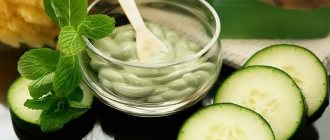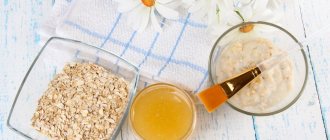Today, probably, every young woman can easily name many popular cosmetic companies, the difference in prices, as well as the features of the products they offer. And only not many are truly familiar with the basic rules for using cosmetics, that is, with cosmetic culture.
But only by following these rules can you avoid unpleasant consequences and not harm your loved one.
We often listen to the opinions of our friends or build our own, not always correct, point of view on the topic of using this or that remedy, thereby helping the birth of myths.
If you use several products with SPF, they will increase sun protection
This is also a misconception. The fact is that the degree of sun protection does not have a cumulative effect. And if you use a cream with a sun protection factor of 10, and then also a foundation with a sun protection factor of 20, you will not get protection - 30. In this case, the protection will only be at the highest level of the foundation - 20. But there is no point in adding up these numbers. They don't give such an effect.
Currently reading
Modern women at 30 manage to look younger than their...
Why do an adult’s eyes water and what to do for...
Face creams: myths and truth
What cosmetics do women tend to buy most often? Of course, dear. There is an opinion that cheap face cream is a useless and even harmful product. But is this really so? Let's understand the myths and truths about face creams.
According to cosmetologists, expensive creams are almost no different from affordable cosmetics. Studies have been conducted more than once where participants used the same inexpensive cream. At the same time, one group of women was told that this was an expensive luxury cream, and the other - that it was a cheap ordinary one. As a result, ladies using supposedly elite creams noticed that their skin really began to look better. The placebo effect just worked here.
Therefore, if you prefer to use an expensive brand of cream, use it. But if you want to save money on cosmetics, you shouldn't spend extra money, because you won't notice the difference. Let's debunk the myths about creams so that you understand why you shouldn't spend money on brands.
| Myths | Is it true |
| There is nothing useful in a cheap cream - it's almost Vaseline. | Both expensive and cheap creams have practically the same composition - they are all made on the basis of water and oil. |
| Expensive creams contain rare natural ingredients that take excellent care of the skin, while cheap creams are just chemicals. | Yes, there are creams with extracts of gold, black caviar, silk, etc. But in reality, all these extracts do nothing for the skin - it’s just a marketing ploy. |
| Only an expensive cream helps hide wrinkles and prevents early skin aging. A simple cream cannot do this. | Any product that costs at least 200, at least 10,000 rubles is not able to cope with wrinkles. Only plastic surgery, hardware cosmetology and appropriate injections can do this. |
| The best cream is an expensive and completely natural cream. It penetrates the skin well and saturates it with vitamins. You don't mind spending any money on this cream. | There are no completely natural creams, no matter how much advertising shouts about it. Such creams simply cannot be stored - if you prepare a natural cream with your own hands, it will retain its properties for a maximum of a week, and then only in the refrigerator. And, by the way, the cream does not penetrate anywhere - it creates a protective film on the skin, preventing it from drying out, and retains moisture. |
| You should not apply the same cream to your skin morning and night. There should be one remedy for the night, another for the day. | Yes, day and night creams are really different. Night cream is richer and more nourishing as it should help restore skin cells. And the day cream, which has a lighter texture, protects and moisturizes the skin. |
| The skin gets used to the same cream and it stops working. Therefore, you need to change the cream every six months. | This is not true. You can use the same cream all your life - your skin will not get used to it. Why buy something else if your skin is comfortable with the cream you are using now? |
So, as you can see, there is not much difference between expensive and cheap creams. The main thing is that the cosmetics are of high quality, like Oriflame in Belarus, and affordable. By the way, on the website of the consultant of this company you will find information about cosmetics and accessories, and also learn recipes for homemade skin masks. By the way, if you are going to buy a face cream, pay attention to the texture and smell. The product should smell pleasant and have a homogeneous and not cloudy consistency.
If you liked it, share it with your friends))
Truth and myths about cosmetology
The 21st century has already brought with it many incredible discoveries and fantastic inventions: a flight to Pluto, flying cars, artificial islands in the oceans, but mothers continue to forbid their daughters to dye their hair and advise using baby cream and shampoo with duckling so that the skin does not age prematurely, and the hair was thick and silky.
These myths are quite tenacious and originate from textbooks on cosmetology of the 50s of the 20th century and from clippings from the magazine “Peasant Woman”, section “Notes for the Housewife”. But there are also more modern myths that are associated with aesthetic cosmetology and medicine. Where do they come from? It's hard to say now! But we can dispel them! Let’s say right away that we, specialists at the Irina Aesthetic Medicine Clinic, do not believe in the existence of a miracle cure that will immediately get rid of anything unwanted, or in the existence of a jar of cream that can instantly add attractiveness and youth. If a person smokes, spends little time outdoors, or works under stress, then even using the most modern, expensive cream will not make the skin ideal. You need to approach the issue of your appearance comprehensively and understand that this is a long-term process and you should not expect a miracle in a couple of days. Ideally beautiful skin is not only a set of cosmetics and a set of procedures, it is also a certain rhythm of life, diet, harmony of the inner world and much more. So here we go! THEY SAY: Dysport injections are harmful.
IN FACT . With age, all people develop wrinkles. What to do? Botulinum protein injections (Dysport, etc.) are remarkably helpful in the fight against wrinkles. The procedure itself does not last long, from 15 to 30 minutes. The miracle effect occurs within a few days (finally after 2 weeks) and will last at least until the end of summer, and possibly longer. We work with the drug Dysport, which is produced by the company Ipsen (Ipsen Pharma - a European pharmaceutical company). The production of a drug is a complex technological process that has many degrees of control. The company has been on the market for more than a dozen years. All products are certified and reliable. Dysport is a purified natural protein that can relax active facial muscles to prevent the formation of wrinkles. Under the influence of the drug, wrinkles are smoothed out. But we must warn you that Dysport will not cause harm only if the procedure is carried out by qualified cosmetologists, with a high-quality drug, and after the procedure you follow all the recommendations! We also inform you that a huge number of fakes have appeared on our market!!! Therefore, if you decide to have Dysport injections in unlicensed establishments, you are putting yourself in danger! Don't take risks! Be careful and careful!!!
THEY SAY: Mechanical cleansing of the face leads to enlarged pores and increased facial hair growth.
IN FACT: This will not happen with professional cleaning and subsequent pore-reducing procedures. But self-cleaning actually often leads to enlarged or clogged pores. At home, it is possible to carry out procedures that maintain the condition of problem skin between visits to a cosmetologist. Of course, it is better to use professional line products that contain herbal medicinal components that directly act on reducing skin problems and improving its quality. As for facial hair growth, this may be caused by hormonal imbalances, but not by facial cleansing.
THEY SAY: Problem skin can be treated at home.
IN FACT : It is indeed possible to take care of problem skin at home, but first a dermatologist must determine the cause of acne, which can only progress over the years and as a result of improper and irregular care. In addition, it will still not be possible to carry out deep and effective facial cleansing at home. Self-squeezing of acne leads to inflammatory processes and injury not only to the skin, but also to blood vessels.
THEY SAY: Facial massage leads to stretching of the skin and its rapid aging.
IN FACT : Massage is a wonderful procedure and very useful. Blood supply and nutrition of the skin improves, the outflow of lymph and venous blood increases, swelling and puffiness are eliminated, the secretion of sebaceous and sweat glands is improved, and facial muscles are strengthened. If the massage is performed correctly, the skin turgor will improve, and the muscles will become more elastic from the additional blood supply. Of course, if the massage is performed incorrectly, not along the lines of lymphatic drainage, then you can see increased swelling and pastiness, and, accordingly, changes in tissue. But the cosmetologists of our clinic are trained in the correct techniques.
THEY SAY : Scrubs with peach pits and regular table salt effectively cleanse the skin of the face, especially if used frequently.
IN FACT : Any scrubs must be used very carefully and follow the instructions for use exactly. Scrubs are not recommended to be used more than once a week, but the skin should be healthy, without inflammatory processes, cuts, or allergies. Scrubs with components of plant origin, for example, with peach pits, injure the skin: they lead to microcracks and microcuts, thereby opening access to pathogenic microbes, just like salt crystals, which, in addition, greatly irritate the skin. “Rub your heels, elbows, knees with salt and scrubs, please,” the French say. “But the face and neck - under no circumstances.” At home, it is best to use scrubs with synthetic capsules.
THEY SAY : Contour plastic (fillers) make the face unnatural.
IN FACT : Modern cosmetology has now come to the conclusion that we, cosmetologists, should strive to preserve a natural face, correct some flaws in appearance, reduce the severity of age-related changes, but in no case change the face beyond recognition. The Internet is replete with scary photos of mutilated stars, and more. But in fact, cosmetic procedures can and should be done. And you will look natural, well-groomed and young. What is the key to success? First, you need to clearly understand for yourself that every age has its own charm and the features of appearance are very individual. There is no need to try to adjust your appearance to someone else; for example, lips, like Angelina Jolie’s, will not look organic and attractive on every face. Take your choice of a cosmetologist very seriously. Firstly, it should only be a doctor!!! And not a former accountant who took a short-term course somewhere (yes, unfortunately, this also happens). This should be a cosmetologist with a certificate in cosmetology (and not a urologist, for example). The cosmetology clinic you decide to go to must have a medical license. If the first 2 conditions are met, then at least you will be insured against counterfeit drugs that flood our market. The drugs that are offered to you must be registered with Roszdravnadzor (you can check this on the drug’s website or look at the registration certificate at the clinic). Pay attention to what the doctor himself looks like, ask to see a “before and after” photo of his work. And remember that the highest aerobatics in cosmetology is when they simply give you compliments, and do not point a finger at the places where the cosmetologist’s hand was applied! Be beautiful and natural!
THEY SAY : Apply any cream in a thick layer, and after a while the excess is removed with a napkin.
IN FACT: The skin absorbs as much cream as it needs, so applying a thick layer is a clear overuse of cream. Moreover, modern creams have a very light and delicate texture. So, if the cream is absorbed and does not leave a shine, this does not mean that you need to add more. There should be a very rational approach to the use of creams and emulsions. And no getting wet!
THEY SAY : Dry skin does not need to be cleaned: there are no blackheads and oily sheen, this is not problem skin.
IN FACT : Dry skin, as well as combination and oily skin, needs to be cleansed, only for different skin types there are different frequency and types of cleansing. For dry skin - at least once every one and a half to two months. For fatty women - more often.
THEY SAY: Combination and oily skin does not need to be moisturized.
IN FACT : Any type of skin needs additional hydration, especially in winter. Hot radiators, air conditioners, cold wind, heat - all this deprives the skin of moisture and leads to its premature aging. In winter, dehydrated, oily skin can flake just like dry skin. Solution: apply a moisturizing mask to the skin once a week, use a moisturizer or emulsion (for oily skin) once a day and drink plenty of clean water.
THEY SAY: Oily skin must be wiped with alcohol solutions to destroy germs and cauterize acne.
IN FACT : Alcohol dehydrates any skin type. Under the pores tightened with alcohol, fat accumulates and pustules form. Please note that all professional cosmetics and cosmetics of expensive brands do not contain alcohol.
THEY SAY: Foundations clog pores.
IN FACT : It is better for teenagers not to overuse decorative cosmetics, but only to locally mask skin defects with special tinting pencils with a therapeutic effect, which are sold at the Irina clinic (manufactured by the Belnature company). In general, modern foundation creams do not clog pores; if they are selected correctly according to your skin type and applied to clean, well-groomed skin, there will be no harm.
THEY SAY : Tanning is good for facial skin: it looks healthy, acne disappears, wrinkles are smoothed out.
IN FACT : The results of dermatological studies have long proven that ultraviolet radiation is unsafe for the skin in general and for facial skin in particular. The external effect of tanning can only be short-term: intense and frequent absorption of ultraviolet radiation leads to the fact that the skin begins to age ahead of time, fine wrinkles worsen, the skin loses tone and moisture, collagen is destroyed, and acne most often worsens. But with proper use of sunscreen, glasses, and hats with a visor, photoaging can be avoided.
THEY SAY : Epilation causes hair to grow more intensely and become darker.
IN FACT : It all depends on the method of hair removal. For example, the more often you epilate, the weaker your hair becomes and the less often it grows. Perhaps the most effective methods of hair removal today are photo and laser hair removal, followed by electrolysis in popularity. Hair is also removed using depilation. Types of depilation: wax, sugaring, creams, electric depilators, shaving. Popular depilatory creams are equivalent in their effect to shaving; in addition, they can cause dermatitis. But really, why does hair become denser and darker after shaving or removing it with cream? This is because as it grows, the ends become blunt rather than tapered, like hair that has never been shaved or trimmed. It has been proven that shaving does not affect hair growth and thickness. Another myth concerns eyelash growth. Some believe that if you cut off the ends of your eyelashes, they will become longer and thicker. It's a delusion.
It is impossible to get rid of unwanted hair growth forever or for a very long time! Not everyone can tell what is the difference between hair removal and depilation. But in reality everything is simple. Depilation involves removing unwanted hair from the body using sugaring, waxing, creams, shaving, electric depilators or even tweezers. After cream and shaving, hair begins to grow within a week, and after waxing and sugaring after about a month, since it is not cut, but pulled out. Depilation is simple and popular. She is preferred by most women and girls. Still would! There are many advantages, but minimal contraindications. In addition, depilation can also be done at home.
As for hair removal, it permanently gets rid of unwanted hair anywhere. During the procedure, hair follicles are destroyed under the influence of electric current or laser. Epilation is a more serious procedure when compared to depilation. It includes many methods that have a common feature: a deep effect on the bulbs. The long-term result cannot but rejoice. This procedure is exclusively salon in nature, that is, there is no way to do it at home!
THEY SAY: Special creams can get rid of cellulite forever.
IN FACT : We have to disappoint: women have always suffered from cellulite and will continue to suffer. This is a physiological state of the body (there is only a small percentage of women who do not even show signs of cellulite). It is more important to determine the stage of cellulite. Anti-cellulite creams, at best, improve the quality of the skin and have a mainly superficial effect. More effective, of course, are the special anti-cellulite programs that we use in our clinic: they are aimed at improving skin texture, microcirculation, and removing toxins, waste, and excess fluid from the body. With cellulite, prevention is most important, and a single course of therapy is not enough. Nutrition and exercise are also important.
THEY SAY: Facial exercises help prevent ptosis
IN FACT: There is no research to support or refute this claim. Traditional procedures for combating ptosis are more effective: laser liposuction, Aptos threads and SMAS lifting.
THEY SAY: if you stop doing mesotherapy, your face will collapse.
IN FACT: Your face will definitely not collapse, as the skin becomes denser. If we regularly inject hyaluronic acid, do biorevitalization, injections, then the skin becomes more elastic and dense. This is noted by the patients themselves. It is impossible for hyaluronic acid to improve the quality of muscles or act on the ligamentous apparatus, but it is quite possible to improve the quality of the skin. If you stop going for procedures, then your skin will eventually return to its previous state as before the start of the procedures, but it will not collapse, that’s for sure.
is possible: of course, if you fill, for example, nasolabial folds with gel for a long time, and then stop, the difference will be noticeable in contrast. But it’s not the face that has collapsed, it’s just that the drug has gone away, while the face remains the same as it would have been without the injections. And even a little better, because if a woman has been taking care of herself for a long time with the help of a cosmetologist, she still looks better than if she did not do this at all.
THEY SAY: Cavitation is a means of bringing your figure to ideal proportions.
IN FACT : If they tell you that cavitation turns chubby women into fit, slender women, don’t believe it. Cavitation is not yet able to solve such problems. Perhaps, in a few years, the development of technology will give it truly limitless possibilities, but for now it is aimed mainly at solving local problems: removing the so-called “ears” on the hips, smoothing out the bumps on the stomach, and so on. Few people, when trying to improve their figure, limited themselves to cavitation alone. As a rule, lymphatic drainage massage sessions and sports training are carried out in parallel, major changes are made to the daily diet, and other comprehensive measures are taken - they are usually selected by a cosmetologist. Individual recommendations in each individual case are different - after all, the general state of health, the absence of contraindications, and the presence of chronic diseases are taken into account. Cavitation is based on the properties of ultrasound. It penetrates into the subcutaneous fat, and under its action the membranes of fat cells are destroyed. Pros: cavitation affects only fatty deposits without harming muscle, cartilage, connective and bone tissue; nerve endings are also not affected; by breaking down subcutaneous fat, cavitation has a beneficial effect on the upper layers of the skin - it helps to smooth its surface and eliminate the signs of cellulite; the procedure is painless and does not require anesthesia. There are also disadvantages, which we will tell you about during a free consultation at our clinic.
THEY SAY: Laser lipolysis is painful and scary.
FACT : Fat cells are responsible for the synthesis and storage of fat. During the first year of a child's life, they triple in size and continue to divide and grow until the age of 5. After this, in most people, fat cells lose their activity to reproduce and only increase in size. Fat cells are most numerous in the areas of the outer surface of the upper third of the thigh, the inner surface of the knee joint, the groin area, the abdominal area under the ribs, as well as in the area of the chin (double chin). We have cells in our body that block lipolysis and prevent the fat cell from “losing weight.” Perhaps it is this factor that explains the insensitivity of fat deposits in these areas to various diets and physical activity. A radical way to restore the damaged contour of the figure in these cases may be laser lipolysis. The procedure is painless. Local removal of most of the fat cells leads to the fact that the remaining part of the fat cells is no longer able to reproduce the same volume due to additional accumulation of fat. Even at an older age, you can get amazing results after laser lipolysis. As for the double chin, even if you plan to remove it with the help of plastic surgery (for example, a circular facelift), laser lipolysis carried out previously (6 months before) will remove the excess volume of the chin and after the operation you will get a perfect oval face! But surgery can be avoided. Since after laser lipolysis, after 2-3 months you can tighten the skin using Aptos threads or the SAMAS lifting procedure.
LiveInternetLiveInternet
Monday, September 09, 2013 20:39 + to quote book
Foundation clogs pores, ointment for hemorrhoids helps remove bruises, and horse shampoo is good for hair - forums are full of these legends; your friends have probably told you about them more than once, and you have already tested some of them for yourself. Experts have dispelled all the myths and told which of them have a real basis and which do not.
Foundation clogs pores
It is a fact. Oil-based foundations containing lanolin, isopropyl myristate, synthetic dyes, fragrances, preservatives and micronized particles actually clog pores and cause breakouts. If you use such products, to avoid clogging your pores, you must thoroughly cleanse your skin before applying and work out the relief with a foundation - this invisible shield will protect you from irritation. True, now a lot of “multi-station” miracle products have appeared on the market, combining the functions of care, treatment and camouflage - these are the famous BB and CC creams. They do not cause irritation, but, on the contrary, have a healing effect on the skin and mask all imperfections well.
Horse shampoo is good for hair.
This is a myth. The parable about the benefits of horse shampoo spread across our country after an interview with Jennifer Aniston that was incorrectly translated into Russian. The actress, in response to a question from journalists about how she cares for her hair, said that she uses collagen-based shampoo, which is obtained from horsehair. As a result of translation difficulties, the parable of Aniston washing her hair with horse shampoo was born. Real horse shampoo is not suitable for human scalp. A certain pH (in horses it is alkaline, in humans it is acidic), a lot of tar, silicone and collagen are intended precisely to ensure that the animal’s hair is shiny and beautiful. But the hype around horse shampoos prompted cosmetic product manufacturers to adapt this product for the human scalp. Tar was excluded from the composition, the pH structure was changed, and a certain amount of collagen and silicone was left. The last two components play their seemingly positive role in achieving beautiful hair. They envelop the strand with an invisible layer, thereby thickening it and making it smooth and shiny. But collagen and silicone tend to accumulate in the scalp and hair, therefore, long-term use of horse shampoo can lead to disruption of oxygen circulation, heavier hair and subsequent hair loss. Our experts advise not to strive for “animal beauty” and to maintain hair health using shampoos intended for people, preferably from professional lines.
Hemorrhoid ointment removes bruises
This is a fact.
They say that in order to put herself on alert after binge parties, Kate Moss applies anti-hemorrhoid ointment to her face. This product is also loved by catwalk makeup artists for its ability to quickly remove bruises and swelling under the eyes. Cosmetologists claim that ointment for hemorrhoids is really capable of this if it contains heparin (a substance that prevents blood clotting). True, allergic reactions and other troubles after its use have not been canceled. And why choose this piquant product if there are many products on the market specifically for the face that can remove bruises in a matter of minutes. The skin can be re-moisturized and re-cared for, so you don’t need to use cosmetics all the time.
This is a myth.
It is difficult to over-moisturize the skin; it constantly needs additional nutrition and moisture, regardless of its type. A sufficient amount of moisture in the dermis protects it from drying out, strengthens the “rear” (hydrolipid protective mantle), and helps slow down the natural aging process. The skin gets used to certain cosmetic products, so they become ineffective and need to be changed more often.
This is a myth. However, it is worth clarifying that a line of skin care products with a certain component composition should be selected depending on the time of year. For example, in winter the skin needs active nutrition, in summer it needs hydration.
Mayonnaise will make your hair shiny.
This is a fact.
If we are talking about homemade mayonnaise, then yes, it really can give your hair shine and softness due to the content of natural oils and proteins. But a product prepared industrially with the addition of dyes, preservatives and all kinds of food additives can have the opposite effect. In any case, mayonnaise is inferior in its properties to professional hair care masks and serums. It is not very convenient to apply and is difficult to wash off. In addition, mayonnaise can weigh down the strands and leave a not-so-pleasant aroma on your hair. Toothpaste dries out inflammation.
This is a fact.
Due to the content of anti-inflammatory components, alcohols and menthol, toothpaste can actually dry out inflammation. However, it does not cure the problem itself and, with prolonged use, can dry out the application site too much, cause peeling and allergic reactions on the skin. Organic cosmetics are safer for the skin
This is a myth. Organic cosmetics, as a rule, do not contain artificial fragrances, alcohols, or synthetic dyes. However, this does not make such beauty lines absolutely safe for the skin. Organic creams may contain aggressive natural ingredients, for example, vitamin C, essential oils, proteins, which can cause severe allergic reactions.
Body sunscreens cause skin cancer
This is a myth.
Scientists have proven that titanium oxide and zinc dioxide, which are all accused of aggressively affecting dermal cells, work only on the surface of the skin, protecting it from exposure to aggressive sun rays. Their molecules are too large, so they cannot penetrate deep into the skin and interact with skin cells. You should always use cosmetics from only one line.
This is a myth.
It is believed that products from the same line within the same brand complement and enhance each other’s actions due to their component composition. However, based on the individual needs of your skin, a lotion from one brand's collection may be suitable for you, and a cleansing gel from another brand. Creams labeled day/night are a marketing ploy.
You can use one cream, regardless of the time of day. This is a myth. It’s not for nothing that face creams are divided into day and night. The fundamental difference between a day cream and a night cream is that the former contains sunscreen filters and components that protect the skin from the negative effects of external factors - cold, wind, snow or rain. Night cream contains more nourishing and moisturizing elements, allowing the skin to rest and recover during sleep. Therefore, if you want to maintain healthy and youthful skin for many years, your collection should include both day and night cream.
Homemade cosmetics based on grandma's recipes are much safer for the skin than those produced by cosmetic concerns.
This is a myth.
Homemade cosmetics are less effective for the skin than factory-made ones. The fact is that scientists from laboratories of cosmetic brands add special loosening components to products, which deliver the necessary substances inside the dermis, where all the main processes of its healing, strengthening, and regeneration take place. Homemade beauty products only work on the surface of the skin and can provide some nourishment and hydration. The lack of sun filters in handmade beauty products is also a significant disadvantage. In addition, you need to take into account one important thing - before you start preparing a homemade “potion”, you need to know exactly the effect of each ingredient on your skin, as well as the rules for combining the components with each other. Vaseline saves you from wrinkles.
This is a myth. Vaseline is part of a cosmetic product, the basis of dermatological ointments. It softens the skin and prevents moisture evaporation. However, performing solo, he is not able to cope with the problem of aging and help in getting rid of wrinkles. Vaseline actively works only with the support group of other components in creams.
Olive oil helps with stretch marks
This is a myth.
Olive oil contains a large amount of vitamin E, removes toxins and waste from cells, helps restore the skin, and actively moisturizes it. This natural product accelerates the production of collagen and elastin, the main elements that make the dermis smooth, firm and elastic. True, olive oil is powerless against stretch marks that have already appeared; rather, it is suitable as a means of preventing them. If you comb your hair 100 times a day, it will shine.
This is a myth. You really need to brush your hair throughout the day. This massage increases oxygen circulation, stimulates hair growth, and allows natural oils from the scalp to be transferred to dry ends (thus, the strands are moisturized along the entire length). But excessively frequent combing 100 times a day leads to hair breakage and destruction. Limit this process to 15-20 times. Use a comb with natural bristles, such as boar. Never pull your hair when combing and be as gentle as possible with it. Katerina Popova oneoflady.com
Series of messages “Body Beauty”:
Part 1 - What fetal anti-aging cosmetics are made of Part 2 - 8 rules of beauty and health. This is interesting! ... Part 20 - Patterns for braiding long hair. Part 21 - Methods of using Vaseline. Body care Part 22 - Myths and facts about cosmetics Part 23 - How to choose a corrector for the skin Part 24 - Ideas for manicure ... Part 35 - 8 ideas on how to use familiar cosmetics in an unusual way Part 36 - 6 ways to distinguish original perfumes from fakes Part 37 - How to give yourself a beautiful hairstyle
Tags:
cosmetics body care hair care facial care
Cited 3 times Liked by: 4 users
Like share
0
Like
- 4
I liked the post - Quoted
- 0
Saved
- Add to quote book
- 0
Save to links
Liked4
0
A little history...about the origin of cosmetic cream
Dear friends, I do not pretend to be a pioneer! I just asked myself a question, found a lot of information and tried to present it in an accessible way. I hope someone will be interested
The history of the cream begins in the distant ancient world, when primitive people began to wash themselves, cleanse and soften their skin, protect it from the sun, wind, rain, snow, and tried to make their appearance more attractive. Observations of archaeologists and scientists studying the life of tribes and peoples, tribes that have survived to this day and are at the lower stages of development, confirm this. “Cosmetics” of the ancients was associated with knowledge of the properties of plants, with experience in the use of various products of plant and animal origin, and minerals.
Historians attribute the creation of the first creams to Egyptian physicians . The first face creams were discovered during excavations in Egypt. Infusions of flowers and healing, tonic additives were added to these creams.
The “fathers” of cosmetics based on plants and aromatic oils are considered to be the sages Imhotep and Ptahhotep , who prepared their products for the highest caste - pharaohs and priests.
By the way, if we delve a little deeper into the history of the Egyptian cult of beauty and caring for one’s body, which Queen Cleopatra followed (let’s leave aside the debate about her beauty), then we can try to create one of these wonderful beauty products today! We are talking about the famous milk baths of Cleopatra: in the original they were made from donkey milk, almond oil and they were added... well, in general, let's try to make a slightly modified analogue at home :)
Fill the bath with water at a temperature of 37-38 degrees. Dissolve a small portion of honey in a liter or two of hot milk and pour this milk into the bath. If you have almond oil, you can add 1-2 tablespoons. Take, like Cleopatra, for 15-20 minutes, kneading the skin.
use a skin scrub before Cleopatra's bath Mix sea salt (or ground scrub from coffee grounds) with thick (above 20%) cream, you can also add a little butter and rub the body skin.
We got a little distracted: let's continue.....
Later, the ancient Greek healer Hippocrates created many unique formulas of creams for fading and aging skin.
His follower Diocles prepared compositions for whitening, moisturizing and youthful looking faces.
In Ancient Greece there was a special cult of the body, cleanliness, hygiene, and health, glorified by history and literature.
After long and thorough washings of the face and body, creams, oils, and aromatic products were rubbed into the skin. The Middle East had a strong influence on Ancient Greece, supplying it not only with incense, but also with a culture of aesthetics and hygiene. Aromatic oils, fats and many other cosmetics were produced in Greece. The Greeks adopted recipes for making face creams from the Egyptians.
The word " Cosmetics " is Greek. However, it must be said that the ancient Greeks were more interested in medicinal cosmetics than decorative ones. Nevertheless, we must say to the ancient Greek beauties and beauties for scrubs and peelings, because... They washed themselves with fine sand.
A fragment of Ovid’s poem “Facial Rubs” (1st century AD) has been preserved, in which recipes are set out in verse.
Ovid advises women to get a good night's sleep to refresh themselves, and then take care of the whiteness of their skin: rub themselves with an ointment made from honey, eggs, mashed gladiolus bulbs and powder from barley and wheat grains ground into flour, vetch, and crushed deer antler. The poet promises that the face will become whiter than the mirror.
He also mentions blush made from poppy petals and specifically clarifies that a woman’s best beauty is good manners.
A “pot” is often mentioned as a vessel for preparing cosmetics; it is logical to assume that the prepared products were kept in some small pots.
In the Mediterranean, the cream was based on olive oil. But African tribes used raffia palm oil. In Oceania, coconut oil was used, which was mixed with palm and castor oil, and sometimes even with cow oil with mahogany additives. Sometimes ginger root, herbs or metal dust were used instead of mahogany.
According to historical data, in Ancient Rome the personal doctor of Marcus Aurelius Claudius Galen, created a cream from wax, spermaceti, water and almond oil, and called it “cold cream,” which translated means “cold cream.”
This cream was used for many years and was the one and only. The composition of this cream was simple: rose hydrosol, beeswax, almond oil and rose ajusolute (optional). Its function was to nourish and soften the skin. It perfectly moisturized and made the skin velvety, thanks to which it quickly won the hearts of Roman beauties. But the wax clogged the pores, preventing the skin of the beauties from being saturated with oxygen.
In ancient Russia, the first known healer was the granddaughter of Vladimir Monomakh, Eupraxia. She had extensive knowledge in medicine, which she preserved in her clinic “Ointments”. In it, among other things, she saved recipes for body and face care.
It is worth noting that from time immemorial in Russia the bathhouse was revered . Most often, this is where cosmetic “rituals” . They used honey, rye bread, and herbal infusions. To refresh the skin, massages were done with herbal ointments.
Cosmetics in Rus' contained products of animal origin (milk, sour cream, honey, egg yolk, animal fats) and various plants (cabbage, carrots, beets, cucumber).
Burdock oil was used for hair care. Cucumber juice and parsley decoction made the face white, fats softened the skin of the face, neck and hands.
Women in Rus' collected flowers, grass, fruits, roots, berries and prepared cosmetics themselves. Cornflower infusion was used to wipe oily, porous skin. Plantain was used for healing, and leaves of coltsfoot and nettle were used against dandruff and hair loss.
In the Middle Ages , despite the decline in demand for cosmetics, doctors continued to create new cream formulas. Dr. Abu al-Qasim al-Zahrawi came up with hundreds of recipes for anti-age care and became the “father” of modern lipsticks and solid deodorants. 300 years later, the English physician Heinrich Mondville drew everyone's attention to rose water. He advised using it to wash your face in the morning and evening. Such care, in his opinion, contributed to the firmness and elasticity of the skin.
In medieval Europe, the use of cosmetics was prohibited by strict religious morals. Even water at this time was declared to be the source of almost all diseases. And only with the advent of the Renaissance did people remember decorative cosmetics. It was during this time that the art of “face painting” was born .
During the Renaissance, active production of cosmetics began in France. At the court of Queen Catherine de Medici, face whitening products with a “poisonous” composition enjoyed particular success. For the Medici herself, the creams were prepared by the doctor Rene Florentine.
In 1566 in France, under Catherine de Medici, it was possible to appear at court only with makeup on the face, powdered hair and well-groomed hands. Particular attention began to be paid to the condition of hands and nails, which was associated with frequent epidemics that spread due to lack of hygiene. Aristocrats, in order to preserve the youth and white color of the skin of their hands, made masks from rendered lard. They smeared it on their brushes, and put on thin leather gloves on top. They kept their hands in this compress all day long. Hand cream at that time was unsafe. In the Middle Ages, it included poisonous lead, acetic acid and crushed pearls.
In 1806, the book “Encyclopedia of Beauty” . It contained advice on how to maintain “unfading freshness of the skin” and how to get rid of wrinkles.
In the 19th century The requirements for cosmetics have changed, the range of aromatic substances and skin and hair care products has expanded, which immediately affected the production technology of perfumes and cosmetics. Unfortunately, people began to forget about folk hygiene and cosmetics.
Today's creams, like in ancient times, are made on the basis of fats, biologically active components and, of course, water. Emulsifiers are added to mix fats with water.
In the early 60s, scientists understood one of the reasons for skin aging . It was a lack of collagen. At this time, fish collagen, a biologically active component, was discovered in Poland. It was produced by the Polish company Inventia. It is included in many cosmetic products. However, the formula of the creams was simple, and the components coped with their tasks very poorly. Therefore, soon the effect of such products was aimed exclusively at combating fine wrinkles.
The first anti-aging creams with liposomes appeared in 1983. According to their creators, liposomes were supposed to overcome the epidermal barrier, delivering active elements to the skin. However, later this technique turned out to be ineffective. And then the American dermatologist Albert Klingman from the University of Philadelphia proposed the concept of Cosmeceutical - “cosmeceuticals”. It meant products with complex formulas. Such drugs have come to be considered the most effective.
By the end of the 20th century, a boom in antioxidants began - means to fight free radicals, which by that time had already been recognized as a factor in skin aging. Thanks to this discovery, the compositions of creams were filled with new substances, for example, vitamin C, the main opponent of aging.
There are many types of creams available these days. They are created for different skin types and ages. Each type of cream has its own use. There are creams: moisturizing, nourishing, mattifying, cleansing, sunscreen, protective, self-tanning, foundation, baby cream, healing cream, anti-aging….
Here is a short excursion into history, I hope it was interesting
Have a great mood everyone!
Best regards, Olga

